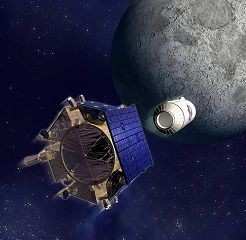LCROSS To Piggyback On Spring LRO Launch
 NASA has selected four teams to
observe the impact of the Lunar Crater Observation and Sensing
Satellite, known as LCROSS, with the lunar surface during the
mission's search for water ice on the moon.
NASA has selected four teams to
observe the impact of the Lunar Crater Observation and Sensing
Satellite, known as LCROSS, with the lunar surface during the
mission's search for water ice on the moon.
The LCROSS mission is a small companion mission to the Lunar
Reconnaissance Orbiter, scheduled to launch from Cape Canaveral in
spring 2009. Instruments aboard the satellite are designed to
search for evidence of water ice on the moon as the spacecraft
collides with a permanently shadowed crater near one of the moon's
poles. The resulting debris plumes are expected to be visible from
Earth with telescopes 10-to-12 inches in diameter or larger.
These chosen observation teams will provide additional data and
analysis about permanently shadowed craters to help researchers
determine if water exists on the moon and in what form. The LCROSS
mission and the Universities Space Research Association, or USRA,
of Columbia, MD, established specific selection criteria. USRA
administered the rigorous selection process.
"The LCROSS team is extremely pleased with the quality of
proposals received," said Jennifer Heldmann, lead for the LCROSS
Observation Campaign at NASA's Ames Research Center in Moffett
Field, CA. "The contributions from the selected observation
proposals will contribute substantially to the LCROSS mission."
The selected proposals are:
- Accessing LCROSS Ejecta: Water Vapor and Particle Size and
Composition from Keck, Gemini, and the IRFT Telescopes; principle
investigator Eliot Young, Southwest Research Institute in Boulder,
CO
- LCROSS Lunar Plume Observations with the Apache Point
Observatory; principle investigator Nancy Chanover, New Mexico
State University in Las Cruces.
- Multi-spectral Imaging of the LCROSS Impact; principle
investigator Marc Buie, Southwest Research Institute.
- Searching for Polar Water Ice During the LCROSS Impact Using
the MMT Observatory; principle investigator Faith Vilas, University
of Arizona in Tucson.
"We are proud to be a part of the process that will enable these
very important observations and look forward to working with the
principal investigators and our NASA counterparts to ensure success
in the observation campaign," said Frank Curran, director of USRA's
Operations in Huntsville, AL. Curran was USRA's coordinator for the
selection process.
On the night of the impacts, the LCROSS science team will be in
constant contact with professional astronomers to provide live
targeting information. This information is crucial to ensuring the
astronomers point their large telescopes correctly to capture the
exact moment of the impacts and the resulting debris plumes.
NASA's Ames Research Center developed the LCROSS science
payload. Ames also is managing the project and conducting mission
and science operations. NASA's Lunar Precursor Robotic Program at
NASA's Marshall Space Flight Center in Huntsville managed the
cooperative agreement with USRA.
 ANN's Daily Aero-Linx (05.02.24)
ANN's Daily Aero-Linx (05.02.24) ANN's Daily Aero-Term (05.02.24): Touchdown Zone Lighting
ANN's Daily Aero-Term (05.02.24): Touchdown Zone Lighting Aero-News: Quote of the Day (05.02.24)
Aero-News: Quote of the Day (05.02.24) ANN FAQ: Contributing To Aero-TV
ANN FAQ: Contributing To Aero-TV NTSB Final Report: Cirrus Design Corp SR20
NTSB Final Report: Cirrus Design Corp SR20



